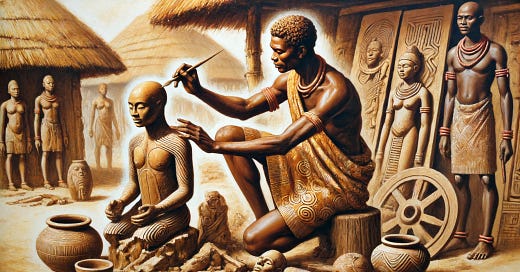The Ancient Nok Culture: Pioneers of Iron and Art
Did you know Nigeria had an Ancient Super Civilization ?
The Ancient Nok Culture: Pioneers of Iron and Art
The Nok culture, flourishing between 500 B.C.E. and 200 C.E. in modern-day Nigeria, represents one of the earliest iron-working societies in Western Africa. Discovered in 1943 by archaeologist Bernard Fagg, the Nok culture is renowned for its distinctive terracotta sculptures and advanced iron-smelting technology. These remarkable achievements highlight the Nok as a sophisticated and influential civilization, whose contributions to art and metallurgy laid important foundations for subsequent African societies.
Central to the Nok's cultural legacy are their terracotta sculptures, characterized by unique artistic features such as triangular or oval-shaped eyes and elaborate hairstyles. These sculptures, often depicting human heads, full figures, and animals, offer a glimpse into the artistic sensibilities and social structure of the Nok people. The widespread discovery of these artifacts, spanning over 78,000 square kilometers, suggests a well-organized society with a centralized authority that controlled the clay supply, indicating significant social and political cohesion.
In addition to their artistic achievements, the Nok culture is notable for its early adoption of iron technology. Evidence from archaeological sites like Taruga reveals that the Nok were proficient in iron smelting as early as the fourth century B.C.E. This technological leap allowed them to produce iron tools and weapons, providing a significant advantage over neighboring societies still reliant on stone tools. Interestingly, the Nok bypassed the intermediary stages of copper and bronze metallurgy, transitioning directly from stone to iron. This unique progression underscores the Nok's innovation and resourcefulness in metallurgy.
The impact of the Nok culture extends beyond their immediate accomplishments. While much about their society remains shrouded in mystery, their influence on later civilizations is evident. Some scholars suggest that the artistry and metallurgical skills of the Nok may have inspired the Ife people, who inhabited the region centuries later and became renowned for their intricate metal sculptures. Although direct connections between the Nok and subsequent cultures remain speculative, the Nok's legacy in art and technology likely resonated through the ages, shaping the cultural and technological development of West Africa.
In conclusion, the ancient Nok culture stands out as a beacon of early African innovation in both art and technology. Their sophisticated terracotta sculptures and pioneering iron-smelting techniques reflect a society of considerable skill and organization. Despite the gaps in our understanding of their social structure and daily life, the Nok's contributions to the cultural and technological heritage of Africa are undeniable. As archaeologists continue to uncover more about this enigmatic civilization, the Nok remain a testament to the rich and complex history of early African societies.
Voice of the Ancestors Book Series






